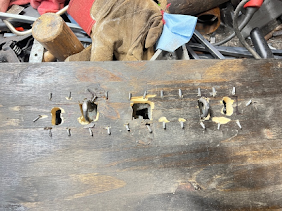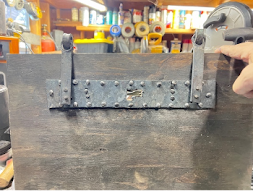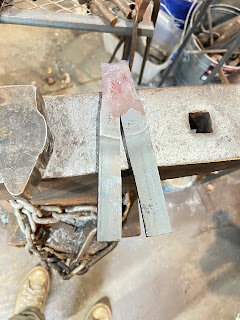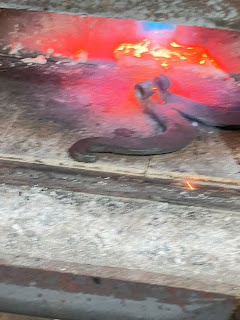This is a project I have been wanting to take on for a very long time. So when my Laurel suggested I make a Viking Age lock as a project it occurred to me, why not go all out. So for this project I created an amalgam of a pressure slide lock system (I will explain firther down), replicas of the Mastermyr Box hinges and what we believe the key would have looked like as there is no physical example in the box, just conjecture, "The keyhole, now corroded, had on vertical and on horizontal slot set at right angles, It's form indicates a simple thin hooked key of a completely different type from the keys with toothed bits which are included in the find"1 The box is just a box, a man must know his limitations.
To start this project, I spent countless hours combing over drawing and pictures of extent slide locks of which there aer precious few; and what we do have are mostly bits and pieces which conjecture can piece back together.
In the case of the Mastermyr Box of which I am mostly copying, you can see in Images 1, 2 and 3 the front plate is missing bits and pieces, but the overall design is intact enough to make a fair guess at is was supposed to look like; amd based on the keyhole it must have been the slide lock design. Unfortunately, we have no photos of the inside of the box, just a very un-detailed sketch (image #2), What's most interesting is that the key for the slide lock which is on the box is nowhere to be found.
According to Göta Berg "The locks on the chest are relatively well preserved and therefore contributes to a better understanding of the construction of this type of lock. Our knowledge hitherto has been based on similiar examples from the Birka and Vendel, but these are in a very poor state". The Mastermyr find and the Birka find mirrored each other in time frame. Birka being dated at 750AD and the Mastermyr find 795 - 1066. What is interesting is these types of slide locks would have been used up until the Middle Ages when tumbler locks were invented.
We have two other examples of slide locks in the box.(image #2). These are reverse key which would slide through a horizontal hole in the box and then pull back back to where the teeth of the key would fit into matching holes on the slide and then the slide would be pulled back against the spring allowing he slide freedom of movement. Images #4. #5 and #6 (this is a reproduction of this type of lock)
I chose to scale down to half scale for the sake of time and sanity. I used a piece of mild steel , 1/8" thick by 2" wide. This closely reflects what was used on the box. By 790 the Viking double bellows forges could reach temperatures as high as 1600-1800 degrees, which created a mild steel from teh introduction of carbon to the Bog iron.

1) The hook on the far end catches the left latch loop (images #26 and #27
2) The center, where I flattened the round bar to accept the square key, is in a place that will allow it to slide closed (image #28)
3) The right end to slide through the latch on the right side. It took several little adjustments with the and without the latches in the holes. (image #29)
The last part of slide system is a pressure plate that rides above the rod and keeps it tight and in place. I forged that out of mild steel and hand made the rivets to hold it in place (Image #39) Showing here the same Mastermyr diagram of the lock (image #31)
- 1 The Mastermyr Find - a Viking Age Tool Chest from Gotland - by Greta Arwidson and Gösta Berg - Skip Jack Press 1999 PAge 8
- 2 Images #6 Viking lock examples - Lodin's Locks - http://www.fjelborg.org/lodinsvikinglocks.htm
- 3 Image #11 Lars Levin Forge and Bellows for the Viking Blacksmith http://levincraftsmanship.wordpress.com/2017/06/11/viking-forge-bellow/
- 4 Images #31 Mastermyr pages 8, Figure 2
- 5 Mastermy page 7











 .#10
.#10

 #13
#13























































